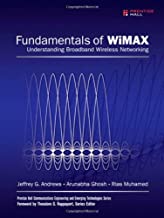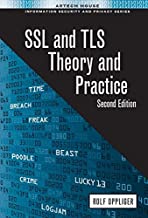Fundamentals of WiMAX: Understanding Broadband Wireless Networking
Original price was: ₹5,403.23.₹4,322.58Current price is: ₹4,322.58.
ISBN: 9780132225526
Author/Editor: Jeffrey G. Andrews
Publisher: PHI
Year: 2007
1 in stock (can be backordered)
Additional information
| Weight | 0.889 kg |
|---|
Product Properties
| Year of Publication | 2007 |
|---|---|
| Table of Contents | Foreword xix Preface xxi Acknowledgments xxiii About the Authors xxvii Part I Overview of WiMAX 1 Chapter 1 Introduction to Broadband Wireless 3 1.1 Evolution of Broadband Wireless 5 1.2 Fixed Broadband Wireless: Market Drivers and Applications 10 1.3 Mobile Broadband Wireless: Market Drivers and Applications 12 1.4 WiMAX and Other Broadband Wireless Technologies 13 1.5 Spectrum Options for Broadband Wireless 17 1.6 Business Challenges for Broadband Wireless and WiMAX 21 1.7 Technical Challenges for Broadband Wireless 23 1.8 Summary and Conclusions 32 1.9 Bibliography 32 Chapter 2 Overview of WiMAX 33 2.1 Background on IEEE 802.16 and WiMAX 33 2.2 Salient Features of WiMAX 37 2.3 WiMAX Physical Layer 39 2.4 MAC-Layer Overview 47 2.5 Advanced Features for Performance Enhancements 55 2.6 Reference Network Architecture 57 2.7 Performance Characterization 59 2.8 Summary and Conclusions 61 2.9 Bibliography 63 Part II Technical Foundations of WiMAX 65Chapter 3 The Challenge of Broadband Wireless Channels 67 3.1 Communication System Building Blocks 68 3.2 The Broadband Wireless Channel: Pathloss and Shadowing 69 3.3 Cellular Systems 77 3.4 The Broadband Wireless Channel: Fading 84 3.5 Modeling Broadband Fading Channels 91 3.6 Mitigation of Fading 104 3.7 Summary and Conclusions 110 3.8 Bibliography 110 Chapter 4 Orthogonal Frequency Division Multiplexing 113 4.1 Multicarrier Modulation 114 4.2 OFDM Basics 117 4.3 An Example: OFDM in WiMAX 123 4.4 Timing and Frequency Synchronization 124 4.5 The Peak-to-Average Ratio 131 4.6 OFDM's Computational Complexity Advantage 142 4.7 Simulating OFDM Systems 144 4.8 Summary and Conclusions 145 4.9 Bibliography 145 Chapter 5 Multiple-Antenna Techniques 149 5.1 The Benefits of Spatial Diversity 150 5.2 Receive Diversity 154 5.3 Transmit Diversity 157 5.4 Beamforming 169 5.5 Spatial Multiplexing 174 5.6 Shortcomings of Classical MIMO Theory 181 5.7 Channel Estimation for MIMO-OFDM 184 5.8 Channel Feedback 189 5.9 Advanced Techniques for MIMO 190 Chapter 6 Orthogonal Frequency Division Multiple Access 199 6.1 Multiple-Access Strategies for OFDM 200 6.2 Multiuser Diversity and Adaptive Modulation 204 6.3 Resource-Allocation Techniques for OFDMA 209 6.4 OFDMA in WiMAX: Protocols and Challenges 216 6.5 Summary and Conclusions 219 6.6 Bibliography 220 Chapter 7 Networking and Services Aspects of Broadband Wireless 223 7.1 Quality of Service 224 7.2 Multimedia Session Management 233 7.3 Security 241 7.4 Mobility Management 249 7.5 IP for Wireless: Issues and Potential Solutions 260 7.6 Summary and Conclusions 265 7.7 Bibliography 266 Part III Understanding WiMAX and Its Performance 269 Chapter 8 PHY Layer of WiMAX 271 8.1 Channel Coding 272 8.2 Hybrid-ARQ 278 8.3 Interleaving 279 8.4 Symbol Mapping 280 8.5 OFDM Symbol Structure 280 8.6 Subchannel and Subcarrier Permutations 282 8.7 Slot and Frame Structure 290 8.8 Transmit Diversity and MIMO 292 8.9 Closed-Loop MIMO 296 8.10 Ranging 300 8.11 Power Control 302 8.12 Channel-Quality Measurements 303 8.13 Summary and Conclusions 304 8.14 Bibliography 304 Chapter 9 MAC Layer of WiMAX 3079.1 Convergence Sublayer 309 9.2 MAC PDU Construction and Transmission 312 9.3 Bandwidth Request and Allocation 316 9.4 Quality of Service 317 9.5 Network Entry and Initialization 319 9.6 Power-Saving Operations 324 9.7 Mobility Management 327 9.8 Summary and Conclusions 332 9.9 Bibliography 333 Chapter 10 WiMAX Network Architecture 335 10.1 General Design Principles of the Architecture 336 10.2 Network Reference Model 337 10.3 Protocol Layering Across a WiMAX Network 341 10.4 Network Discovery and Selection 344 10.5 IP Address Assignment 344 10.6 Authentication and Security Architecture 345 10.7 Quality-of-Service Architecture 349 10.8 Mobility Management 352 10.9 Radio Resource Management 359 10.10 Paging and Idle-Mode Operation 360 10.11 Summary and Conclusions 362 10.12 Bibliography 362 Chapter 11 Link-Level Performance of WiMAX 365 11.1 Methodology for Link-Level Simulation 366 11.2 AWGN Channel Performance of WiMAX 370 11.3 Fading Channel Performance of WiMAX 373 11.4 Benefits of Multiple-Antenna Techniques in WiMAX 387 11.5 Advanced Receiver Structures and Their Benefits for WiMAX 396 11.6 Summary and Conclusions 398 11.7 Bibliography 399 Chapter 12 System-Level Performance of WiMAX 401 12.1 Wireless Channel Modeling 402 12.2 Methodology for System-Level Simulation 404 12.3 System-Level Simulation Results 412 12.4 Summary and Conclusions 421 12.5 Appendix: Propagation Models 422 12.6 Bibliography 427 AcronymsIndex |
| Author | Jeffrey G. Andrews |
| ISBN/ISSN | 9780132225526 |
| Binding | Hardback |
| Edition | 1 |
| Publisher | PHI |
You must be logged in to post a review.






Reviews
There are no reviews yet.